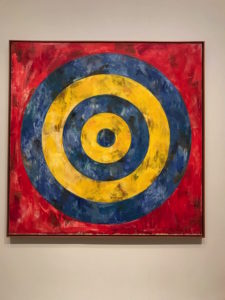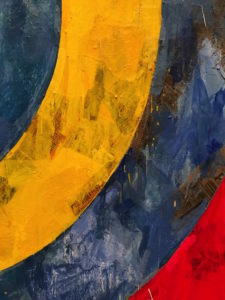 Jasper Johns’ 66 inch square piece is showcased at the Art Institute of Chicago and it jogged some thought. Johns’ intention when he made this and several other target images in the 60’s, was that viewers would see something familiar, “something the mind already knows” as a bridge or a catalyst toward further meaning. He was using the known to pry loose more that is not yet grasped.
Jasper Johns’ 66 inch square piece is showcased at the Art Institute of Chicago and it jogged some thought. Johns’ intention when he made this and several other target images in the 60’s, was that viewers would see something familiar, “something the mind already knows” as a bridge or a catalyst toward further meaning. He was using the known to pry loose more that is not yet grasped.
Jasper’s approach here was a significant departure from the way celebrated American artists were working at the time.
Johns was seeking to communicate. The Abstract Expressionists before him insisted primarily that there was nothing to communicate, only to express (hence Jackson Pollock would usually only number and not title his work). Johns instead was involving the viewer in an investigation. His own expression was not the end point but rather he made things with a certain interest in the receiver of His work. He also was demonstrating an expectation that there were things still discoverable that were valuable. The Abstract Expressionists, on the other hand, were a product of post-war deflation of ideas and of hope (even as some of their work is filled with exquisite gestures of communicative interest in spite of their claims otherwise).
Johns turns a corner on their insistent meaninglessness. He and his friend Robert Rauschenberg used popular signals to prompt the viewer. In fact in the detail here you can see how his medium is part of the messaging. He has embedded newspaper bits into encaustic wax, which hints at much more than just target practice, more than just a simple billboard with primary colors.
I am interested in how Johns seized his moment in history, reflecting on what was immediately vogue yet inadequate, and came up with a way forward. His way is not condescending to his audience, he is inviting them further along with him. That motivation is why this piece is so instructive.
The Abstracters left some damage in the wake of their insular assumptions. Many art newbies resist looking at non-objective work because they think they’re being played by an artist who cares little for their understanding, or who is in some stratosphere above their grasp. They shrink away, feeling belittled.
But Johns and Rauschenberg used common things to speak artfully. Their work was not simple even considering the commonness of items they used. Those common things were stepping stones, an invitation to dialogue with the eyes and with the mind.
To have regard for the viewer or the patron is sometimes mocked as pandering by artists who remain independent characters in any age. But to disdain anyone who stands before your work and not encourage their opportunity to critique and to explore is in my view elitist: a dead end rather than an offered target. The writer Brenda Ueland spoke of a certain necessary generosity with the craft. Her thoughts were a whole new way of encouraging the “why” of doing art for me. And Johns exhibits it.